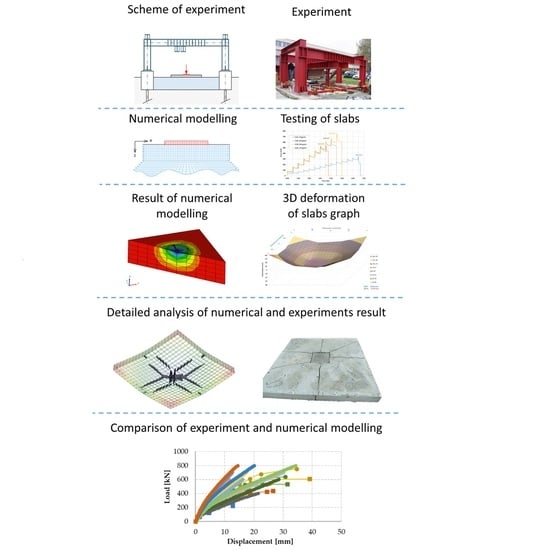Numerical Modeling and Analysis of Concrete Slabs in Interaction with Subsoil
Abstract
1. Introduction
2. Parametric Study and Basic Computational Model
2.1. Experiment—Reinforced Concrete Slab
2.2. Experiment for Reinforced Concrete Slab—Numerical Modeling
2.3. Result of Parametric Study
3. Fiber-Reinforced Concrete Slabs
3.1. Experiments
3.2. Numerical Analysis of Fiber-Reinforced Concrete Slabs on Subsoil
4. Discussion
5. Recommendations for Numerical Modeling of Slabs in Interaction with Subsoil
- (1)
- Current computer technology and numerical methods make it possible to solve the problem using three-dimensional computational models with linear and non-linear solutions.
- (2)
- The chosen finite element method is suitable, and a linear isoparametric eight-node finite element with eight integration points is recommended. The use of tetrahedral finite elements in a non-linear solution can reduce the quality of the solution with respect to the principle of implementation of physical non-linearity. The use of more advanced isoparametric elements also leads to a significant increase in computational complexity.
- (3)
- The size of the finite elements must be chosen appropriately with regard to the dimensions of the structure. Setting the mesh along the thickness of the slab with at least eight finite elements is important for the accuracy of the calculation.
- (4)
- In the case of a linear calculation, the results of deformations are more significantly affected by the subsoil deformation modulus than the stiffness of conventional concrete and the size of finite elements.
- (5)
- The boundary conditions of the computational model must account for the actual geological profile. With greater depth of the model, there are also greater deformations. However, the computational model should not be deeper than the active depth (space) of the subsoil.
- (6)
- Suitable boundary conditions for the subsoil model are for the bottom surface, vertical support uz = 0, and the walls ux = 0 or uy = 0.
- (7)
- For modeling, it is appropriate to use the interface in the fixed contact or interface contact. Such use removes the need for there to be a common finite element mesh. The use of the contact interface significantly increases the requirements for computational complexity and knowledge of input parameters. Contact interface parameters have mixed properties. Some have a physical nature and some are more influenced by the specific geometry of the model. The parameter selection is an iterative process; the model must respect the actual behavior of the structure.
- (8)
- In the case of failure of conventional or fiber-reinforced concrete, it is necessary to use a non-linear solution, where the failure of the cross-section of the slab significantly affects the total deformation.
- (9)
- For the accuracy of the non-linear calculation, the choice of input parameters for conventional or fiber-reinforced concrete is important. The tensile strength of concrete determines the initial formation and development of cracks. During further loading, knowledge of tensile softening or fracture energy is required.
- (10)
- For concrete of ordinary strength classes and composition, it is advantageous to follow the recommendations in Model Codes 1990 or 2020. For fracture energy, it is appropriate to use VOS 1983 from the ATENA theoretical manual [26].
- (11)
- It is more difficult to determine the parameters for fiber-reinforced concrete. There are several approaches to modeling fiber-reinforced concrete and determining constitutive relationships. The basic methods include modeling of concrete and fiber separately [77], the approach presented in this study of using effective values of tensile strength and fracture energy, the definition of tensile softening [2,27], and the approximation of the tensile softening function [1]. When determining the parameters, it is appropriate to proceed from a detailed laboratory program. The basic parameters can be determined similarly to conventional concrete. Specialized tests are then the bending test and the tensile test. It is also appropriate to take into account the stochastic nature [27,78] of the parameters in the resulting parameters.
- (12)
- In the case of a known overall load-bearing capacity of a structure, it is possible to use the Newton–Raphson method. If it is necessary to determine the total load capacity, the descending branch of the calculation must use the arc-length method or the Newton–Rapson method with deformation load. It is also possible to combine methods but as a consequence, the calculation becomes complicated. The proven number of iterations was 30. The loading step should ideally be 1/20 or 1/50 of the total load capacity.
- (13)
- For a non-linear calculation, it is important to check that the experimental failure mechanism is the same.
- (14)
- A balanced compromise should be found between the requirements of the experimental program, laboratory tests, and computational complexity in order to obtain the appropriate value of the knowledge.
6. Conclusions
- The analysis of a slab in interaction with subsoil is a complex task, where conventional concrete, reinforced concrete, and fiber-reinforced concrete slabs behave differently.
- Damage and deformations to fiber-reinforced concrete slabs depend on the dosage of the fibers.
- The influence of the parameters of the subsoil (subsoil deformation modulus and depth of subsoil) increases with a higher load and damage to the slabs.
- In this study, the subsoil deformation modulus had a more significant effect on deformations than the depth of the subsoil.
- Accuracy of the input parameters for the material model is important for analysis and calculations. Individual variants can differ significantly, especially for fiber-reinforced concrete. It is necessary to appropriately identify the tensile strength and fracture energy, which are different from the values for conventional concrete.
- For the solved type of soil–structure interaction task detailed in this study, it is appropriate to use a three-dimensional computational model and non-linear analysis.
Author Contributions
Funding
Acknowledgments
Conflicts of Interest
References
- Valikhani, A.; Jahromi, A.J.; Mantawy, I.M.; Azizinamini, A. Numerical Modelling of concrete-to-UHPC Bond Strength. Materials 2020, 13, 1379. [Google Scholar] [CrossRef] [PubMed]
- Sucharda, O. Identification of Fracture Mechanic Properties of Concrete and Analysis of Shear Capacity of Reinforced Concrete Beams without Transverse Reinforcement. Materials 2020, 13, 2788. [Google Scholar] [CrossRef]
- Falkner, H.; Hunag, Z.; Teutsch, M. Comparative study of plain and steel fiber reinforced concrete ground slabs. Concr. Int. 1995, 17, 45–51. [Google Scholar]
- Hrubesova, E.; Mohyla, M.; Lahuta, H.; Bui, T.Q.; Nguyen, P.D. Experimental Analysis of Stresses in Subsoil below a Rectangular Fiber Concrete Slab. Sustainability 2018, 10, 2216. [Google Scholar] [CrossRef]
- Sucharda, O.; Smirakova, M.; Vaskova, J.; Mateckova, P.; Kubosek, J.; Cajka, R. Punching Shear Failure of Concrete Ground Supported Slab. Int. J. Concr. Struct. Mater. 2018, 12, 36. [Google Scholar] [CrossRef]
- Halvonik, J.; Majtanova, L. Experimental Investigation of the Maximum Punching Resistance of Slab-Column Connections. Slovak J. Civ. Eng. 2018, 26, 22–28. [Google Scholar] [CrossRef]
- Hegger, J.; Sherif, G.A.; Ricker, M. Experimental investigations on punching behavior of reinforced concrete footings. ACI Struct. J. 2006, 103, 604–613. [Google Scholar] [CrossRef]
- Chen, H.-J.; Yu, Y.-L.; Tang, C.-W. Mechanical Properties of Ultra-High Performance Concrete before and after Exposure to High Temperatures. Materials 2020, 13, 770. [Google Scholar] [CrossRef]
- Pająk, M.; Ponikiewski, T. Flexural behavior of self-compacting concrete reinforced with different types of steel fibers. Constr. Build. Mater. 2013, 47, 397–408. [Google Scholar]
- Brandt, A.M. Fiber reinforced cement-based (FRC) composites after over 40 years of development in building and civil engineering. Compos. Struct. 2008, 86, 3–9. [Google Scholar] [CrossRef]
- Ponikiewski, T.; Katzer, J. Fresh mix characteristics of self-compacting concrete reinforced by fibre. Period. Polytech. Civ. Eng. 2017, 61, 226–231. [Google Scholar] [CrossRef]
- Sorelli, L.G.; Meda, A.; Plizzari, G.A. Steel fiber concrete slabs on ground: A structural matter. ACI Struct. J. 2006, 103, 551–558. [Google Scholar] [CrossRef]
- Cajka, R.; Labudkova, J. Dependence of deformation of a plate on the subsoil in relation to the parameters of the 3D model. Int. J. Mech. 2014, 8, 208–215. [Google Scholar]
- Chen, S. Strength of steel fibre reinforced concrete ground slabs. Proc. Inst. Civil Eng. Struct. Build. 2004, 157, 157–163. [Google Scholar] [CrossRef]
- Katzer, J.; Domski, J. Quality and mechanical properties of engineered steel fibres used as reinforcement for concrete. Constr. Build. Mater. 2012, 34, 243–248. [Google Scholar] [CrossRef]
- Sucharda, O.; Bilek, V.; Smirakova, M.; Kubosek, J.; Cajka, R. Comparative Evaluation of Mechanical Properties of Fibre Reinforced Concrete and Approach to Modelling of Bearing Capacity Ground Slab. Period. Polytech. Civ. Eng. 2017, 61, 972–986. [Google Scholar] [CrossRef]
- Alani, A.M.; Beckett, D. Mechanical properties of a large scale synthetic fibre reinforced concrete ground slab. Constr. Build. Mater. 2013, 41, 335–344. [Google Scholar] [CrossRef]
- Alani, A.; Beckett, D.; Khosrowshahi, F. Mechanical behaviour of a steel fibre reinforced concrete ground slab. Mag. Concr. Res. 2012, 64, 593–604. [Google Scholar] [CrossRef]
- Marcalikova, Z.; Cajka, R.; Bilek, V.; Bujdos, D.; Sucharda, O. Determination of mechanical characteristics for fiber-reinforced concrete with straight and hooked fibers. Crystals 2020, 10, 545. [Google Scholar] [CrossRef]
- Malvar, J.L.; Warren, G.E. Fracture energy for three-point-bend tests on single-edge-notched beams. Exp. Mech. 1988, 28, 266–272. [Google Scholar] [CrossRef]
- Hoover, C.G.; Bazant, Z.P. Cohesive crack, size effect, crack band and work-of-fracture models compared to comprehensive concrete fracture tests. Int. J. Fract. 2014, 187, 133–143. [Google Scholar] [CrossRef]
- Khalilpour, S.; BaniAsad, E.; Dehestani, M. A review on concrete fracture energy and effective parameters. Cem. Concr. Res. 2019, 120, 294–321. [Google Scholar] [CrossRef]
- Bazant, Z.; Planas, J. Fracture and Size Effect in Concrete and Other Quasibrittle Materials; CRC Press: Boca Raton, FL, USA, 1998. [Google Scholar]
- Cervenka, V.; Cervenka, J.; Pukl, R. ATENA-A tool for engineering analysis of fracture in concrete. Sadhana 2002, 27, 485–492. [Google Scholar] [CrossRef]
- Cervenka, J.; Papanikolaou, V.K. Three dimensional combined fracture—Plastic material model for concrete. Int. J. Plast. 2008, 24, 2192–2220. [Google Scholar] [CrossRef]
- Cervenka, V.; Jendele, L.; Cervenka, J. ATENA Program Documentation, Part 1, ATENA Theory Manual, Cervenka consulting, 2000–2020. Available online: https://www.cervenka.cz/assets/files/atena-pdf/ATENA_Theory.pdf (accessed on 26 March 2020).
- Sucharda, O.; Pajak, M.; Ponikiewski, T.; Konecny, P. Identification of mechanical and fracture properties of self-compacting concrete beams with different types of steel fibres using inverse analysis. Constr. Build. Mater. 2017, 138, 263–275. [Google Scholar] [CrossRef]
- Vandewalle, L.; Nemegeer, D.; Balazs, L.; Di Prisco, M.A. Rilem TC 162-TDF: Test and design methods for steel fibre reinforced concrete—Bending test. Mater. Struct. /Mater. Et Constr. 2002, 35, 579–582. [Google Scholar] [CrossRef]
- EN 14651:2005+A1:2007(E). Test Method for Metallic Fibre Concrete –Measuring the Flexural Tensile Strength (Limit of Proportionality (LOP), Residual); CEN—European Committee for Standardization: Brussels, Belgium, 2007. [Google Scholar]
- Ros, S.; Shima, H. Relationship between splitting tensile strength and compressive strength of concrete at early age with different types of cements and curing temperature histories. Concr. Inst. Proc. 2013, 35, 427–432. [Google Scholar]
- JCI. Guidelines for Control of Cracking of Mass Concrete; Japan Concrete Institute: Tokyo, Japan, 2011. [Google Scholar]
- JSCE. Standard Specifications for Concrete Structures—2002: "Materials and Construction"; Japan Society of Civil Engineers: Tokyo, Japan, 2005; p. 443. [Google Scholar]
- JSCE. Standard Specifications for Concrete Structures—2007, Materials and Construction; Japan Society of Civil Engineers: Tokyo, Japan, 2010; Available online: https://www.jsce-int.org/system/files/JGC16_Standard_Specifications_Materials_and_Construction_1.1.pdf (accessed on 22 October 2020).
- AIJ. Recommendations for Practice of Thermal Cracking Control of Massive Concrete in Building; Architectural Institute of Japan: Tokyo, Japan, 2008; p. 69. [Google Scholar]
- CEB-FIP Model Code 1990: Design Code, Final version; Thomas Telford Ltd.: London, UK, 1993.
- ACI Committee 318. Building Code Requirements for Structural Concrete (ACI 318-11) and Commentary; American Concrete Institute: Farmington Hills, MI, USA, 2011; p. 111. [Google Scholar]
- Raphael, J.M. Tensile strength of concrete. ACI J. Proc. 1984, 81, 158–165. [Google Scholar]
- Gardner, N.J. Effect of Temperature on the Early-Age Properties of Type I, Type III, and Type I/Fly Ash Concretes. ACI Mater. J. 1990, 87, 529–536. [Google Scholar]
- Oluokun, F.A.; Burdette, E.G.; Deatherage, J.H. Splitting tensile strength and compressive strength relationships at early ages. ACI Mater. J. 1991, 88, 115–121. [Google Scholar]
- Oluokun, F.A. Prediction of concrete tensile strength from its compressive strength: Evaluation of existing relationship for normal weight concrete. ACI Mater. J. 1991, 88, 302–309. [Google Scholar]
- Arioglu, N.; Girgin, Z.C.; Arioglu, E. Evaluation of Ratio between Splitting Tensile Strength and Compressive Strength for Concrete up to 120 MPa and Its Application in Strength Criterion. ACI Mater. J. 2006, 103, 18–24. [Google Scholar]
- Tomasovicova, D.; Jendzelovsky, N. Stiffness Analysis of the Subsoil under Industrial Floor. Procedia Eng. 2017, 190, 365–370. [Google Scholar] [CrossRef]
- Huang, X.; Liang, X.; Liang, M.; Deng, M.; Zhu, A.; Xu, Y.; Wang, X.; Li, Y. Experimental and theoretical studies on interaction of beam and slab for cast-in-situ reinforced concrete floor structure. J. Build. Struct. Jianzhu Jiegou Xuebao 2013, 34, 63–71. [Google Scholar]
- Kueres, D.; Ricker, M.; Hegger, J. Improved Shear Reinforcement for Footings—Maximum Punching Strength. ACI Struct. J. 2018, 115, 1365–1377. [Google Scholar] [CrossRef]
- Augustin, T.; Fillo, L.; Halvonik, J.; Marcis, M. Punching resistance of flat slabs with openings—Experimental investigation. Solid State Phenom. 2018, 272, 41–46. [Google Scholar] [CrossRef]
- Hoang, L.C.; Pop, A. Punching shear capacity of reinforced concrete slabs with headed shear studs. Mag. Concr. 2016, 68, 118–126. [Google Scholar] [CrossRef]
- Beckett, D. Ground-supported slabs made from steel-fibre-reinforced concrete. Concrete 2004, 38, 30–31. [Google Scholar]
- Meda, A.; Plizzari, G.A. New design approach for steel fiber-reinforced concrete slabs-on-ground based on fracture mechanics. ACI Struct. J. 2004, 101, 298–303. [Google Scholar]
- Labudkova, J.; Cajka, R. Comparison of Analysis of Linear Inhomogeneous and Nonlinear Half-Space in Foundation-Subsoil Interaction. J. Mech. 2016, 10. [Google Scholar]
- Alani, A.; Aboutalebi, M. Analysis of the subgrade stiffness effect on the behaviour of ground-supported concrete slabs. Struct. Concr. 2012, 13, 102–108. [Google Scholar] [CrossRef]
- Cajka, R.; Mynarcik, P.; Labudkova, J. Experimetal measurement of soil-prestressed foundation interaction. Int. J. Geomate 2016, 10, 2101–2108. [Google Scholar] [CrossRef]
- Aboutalebi, M.; Alani, A.; Rizzuto, J.; Beckett, D. Structural behaviour and deformation patterns in loaded plain concrete ground-supported slabs. Struct. Concr. 2014, 15, 81–93. [Google Scholar] [CrossRef]
- Barros, J.A.O.; Figuieiras, J.A. Experimental behaviour of fibre concrete slabs on soil. Mech. Cohesive-Frict. Mater. 1998, 3, 277–290. [Google Scholar] [CrossRef]
- Miltenberger, M.A.; Attiogbe, E.K.; Bissonnette, B. Behavior of conventional reinforcement and a steel-polypropylene fiber blend in slabs-on-grade. Mater. Struct. Mater. Constr. 2007, 40, 10. [Google Scholar] [CrossRef]
- Vida, R.; Halvonik, J. Shear assessment of concrete bridge deck slabs. Key Eng. Mater. 2017, 738, 110–119. [Google Scholar] [CrossRef]
- Mari, A.; Bairan, J.M.; Cladera, A.; Oller, E.; Ribas, C. Shear-flexural strength mechanical model for the design and assessment of reinforced concrete beams. Struct. Infrastruct. E. 2015, 11, 1399–1419. [Google Scholar] [CrossRef]
- Collins, M.P.; Bentz, E.; Sherwood, E.G. Where is shear reinforcement required? A review of research results and design procedures. ACI Struct. J. 2008, 105, 590–600. [Google Scholar]
- Mari, A.; Cladera, A.; Oller, E.; Bairan, J.M. A punching shear mechanical model for reinforced concrete flat slabs with and without shear reinforcement. Eng. Struct. 2018, 166, 413–426. [Google Scholar] [CrossRef]
- Classen, M. Shear Crack Propagation Theory (SCPT)—The mechanical solution to the riddle of shear in RC members without shear reinforcement. Eng. Struct. 2020, 210, 110207. [Google Scholar] [CrossRef]
- Mari, A.; Cladera, A.; Bairan, J.M.; Oller, E.; Ribas, C. Shear-flexural strength mechanical model for the design and assessment of reinforced concrete beams subjected to point or distributed loads. Front. Struct. Civ. Eng. 2014, 8, 337–353. [Google Scholar] [CrossRef]
- Fernandez Ruiz, M.; Muttonia, A.; Sagasetab, J. Shear strength of concrete members without transverse reinforcement: A mechanical approach to consistently account for size and strain effects. Eng. Struct. 2015, 99, 360–372. [Google Scholar] [CrossRef]
- Muttoni, A.; Fernandez Ruiz, M. From experimental evidence to mechanical modeling and design expressions: The Critical Shear Crack Theory for shear design. Struct. Concr. 2019, 20, 1464–1480. [Google Scholar] [CrossRef]
- Kozielova, M.; Marcalikova, Z.; Mateckova, P.; Sucharda, O. Numerical Analysis of Reinforced Concrete Slab with Subsoil. Civ. Environ. Eng. 2020, 16, 107–118. [Google Scholar] [CrossRef]
- Montoya, E.; Vecchio, F.J.; Sheikh, S.A. Compression Field Modelling of Confined Concrete: Constitutive Models. J. Mater. Civ. Eng. 2006, 18, 510–517. [Google Scholar] [CrossRef]
- Bazant, Z.P.; Adley, M.D.; Carol, I.; Jirasek, M.; Akers, S.A.; Rohani, B.; Cargile, J.D.; Caner, F.C. Large-strain generalization of microplane model for concrete and application. J. Eng. Mech. 2000, 126, 971–980. [Google Scholar] [CrossRef]
- Sucharda, O.; Konecny, P. Recommendation for the modelling of 3D non-linear analysis of RC beam tests. Comput. Concr. 2018, 21, 11–20. [Google Scholar] [CrossRef]
- Federation internationale du beton. Fib Model Code for Concrete Structures 2010; Wilhelm Ernst & Sohn Verlag fur Architektur und technische Wissenschaften: Berlin, Germany, 2013. [Google Scholar]
- Rimkus, A.; Cervenka, V.; Gribniak, V.; Cervenka, J. Uncertainty of the smeared crack model applied to RC beams. Eng. Fract. Mech. 2020, 233, 107088. [Google Scholar] [CrossRef]
- Cervenka, V. Computer simulation of failure of concrete structures for practice. In Proceedings of the first fib Congress, Osaka, Japan, 13–19 October 2002; pp. 289–304. Available online: https://www.cervenka.cz/assets/files/papers/cervenka_2_osaka_2002_full_e-328.pdf (accessed on 26 March 2020).
- Dias-da-Costa, D.; Cervenka, V.; Graça-e-Costa, R. Model uncertainty in discrete and smeared crack prediction in RC beams under flexural loads. Eng. Fract. Mech. 2018, 199, 532–543. [Google Scholar] [CrossRef]
- Cervenka, V.; Cervenka, J.; Kadlec, L. Model uncertainties in numerical simulations of reinforced concrete structures. Struct. Concr. 2018, 19, 2004–2016. [Google Scholar] [CrossRef]
- Buchta, V.; Janulikova, M.; Fojtik, R. Experimental Tests of Reinforced Concrete Foundation Slab. Procedia Eng. 2015, 114, 530–537. [Google Scholar] [CrossRef][Green Version]
- Marcalikova, Z.; Neuwirthova, Z.; Cajka, R. Parametric Study for Influence of Input Parameters for Analysis of Fibre Reinforced Concrete Slab-Soil Interaction. Trans. Tech. Univ. Ostrav. Civ. Eng. Ser. 2018, 18, 25–30. [Google Scholar] [CrossRef]
- Cajka, R.; Mynarcik, P.; Neuwirthova, Z.; Marcalikova, Z.; Kropacek, M. Tests of fiber reinforced concrete composite slabs on the subsoil with horizontal load. Int. J. Geomate 2020, 18, 143–150. [Google Scholar] [CrossRef]
- Concrete Reinforcement. Available online: http://www.bekaert.com/en/products/construction/concrete-reinforcement (accessed on 22 October 2020).
- Cajka, R.; Marcalikova, Z.; Kozielova, M.; Mateckova, P.; Sucharda, O. Experiments on fiber concrete foundation slabs in interaction with the subsoil. Sustainability 2020, 12, 3939. [Google Scholar] [CrossRef]
- Marcalikova, Z.; Sucharda, O. Modeling of Fiber-Reinforced Concrete and Finite Element Method. Int. Rev. Civil Eng. 2021, 8. [Google Scholar]
- Sucharda, O.; Mateckova, P.; Bilek, V. Non-Linear Analysis of an RC Beam Without Shear Reinforcement with a Sensitivity Study of the Material Properties of Concrete. Slovak J. Civ. Eng. 2020, 28, 33–43. [Google Scholar] [CrossRef]

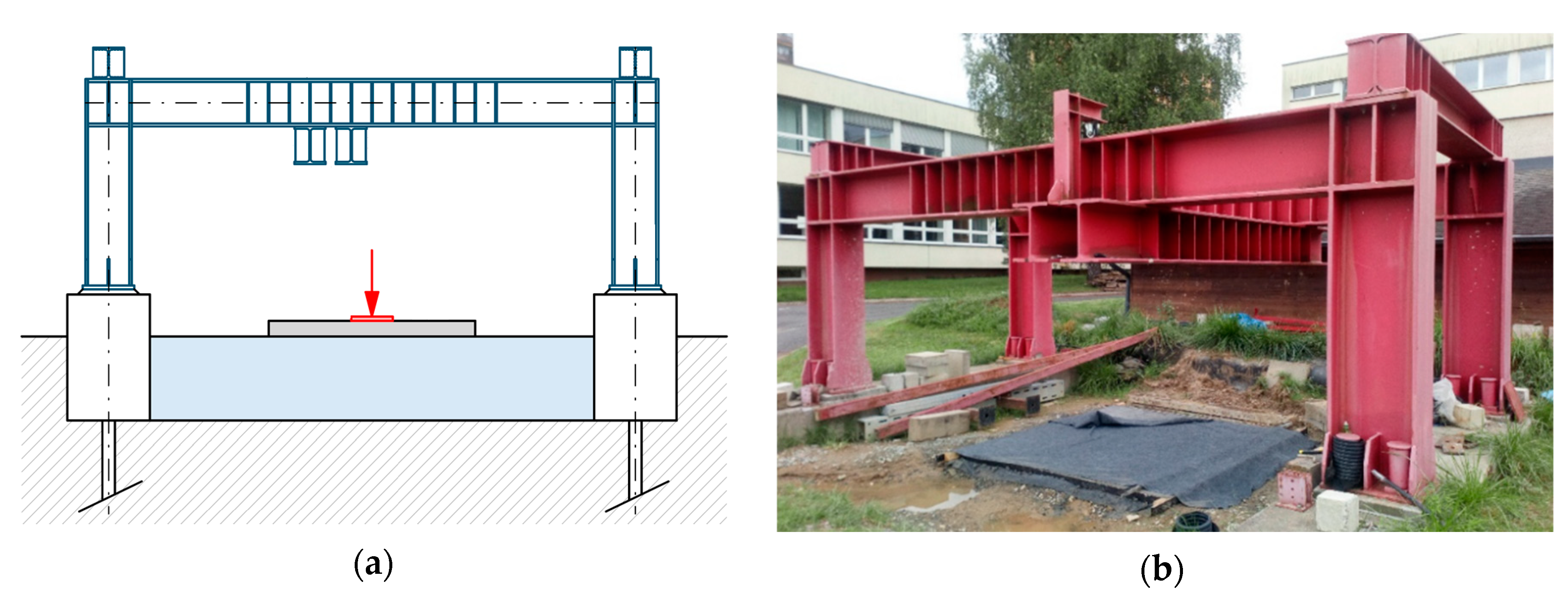
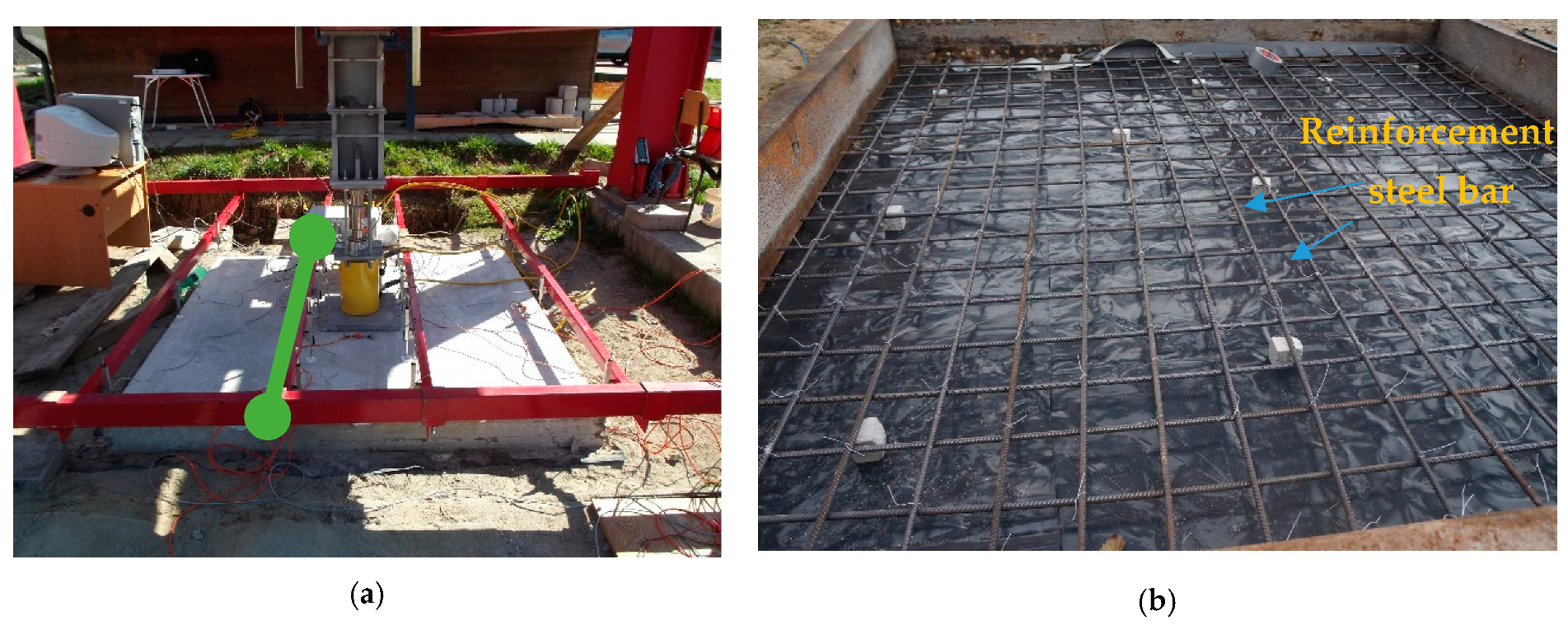
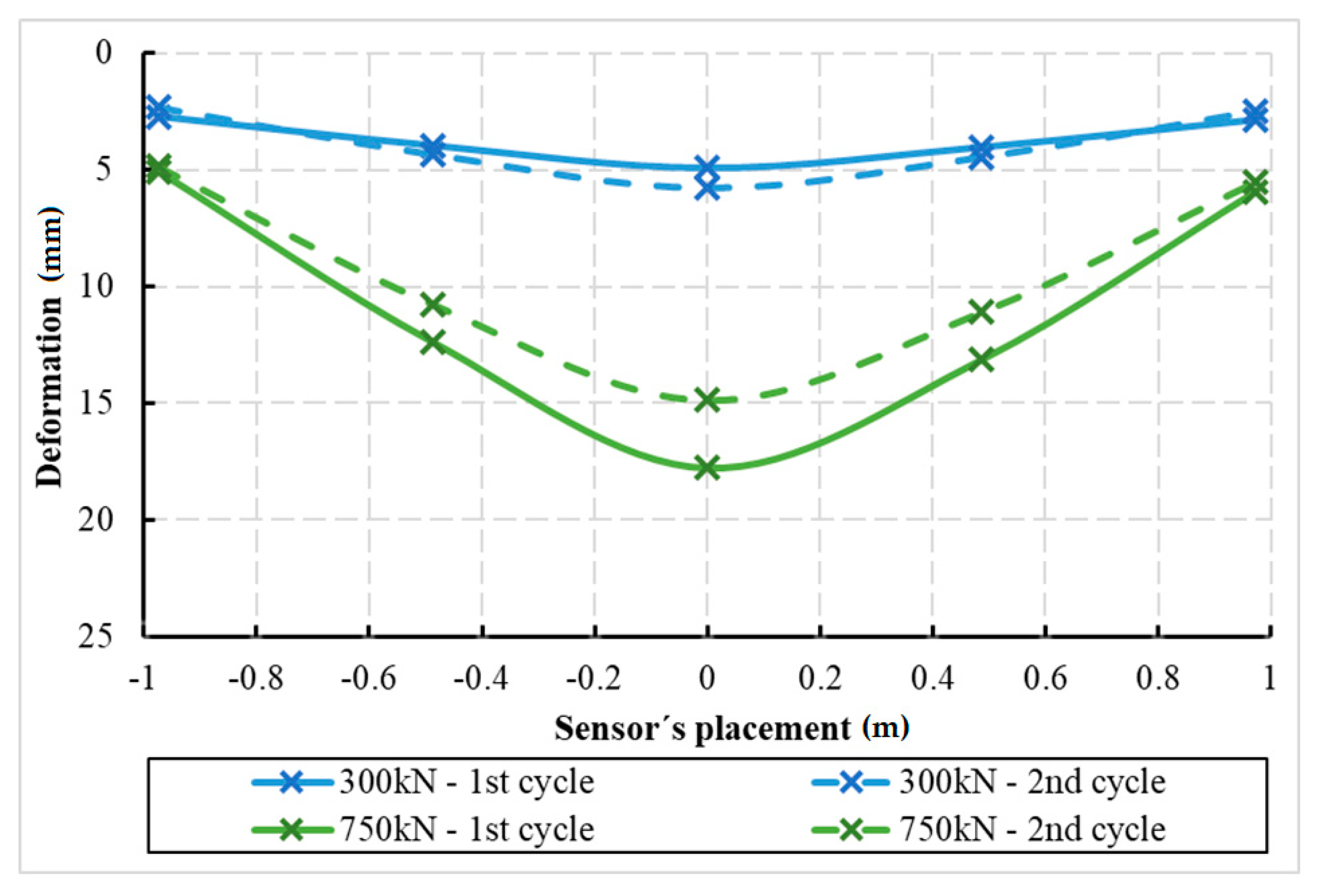
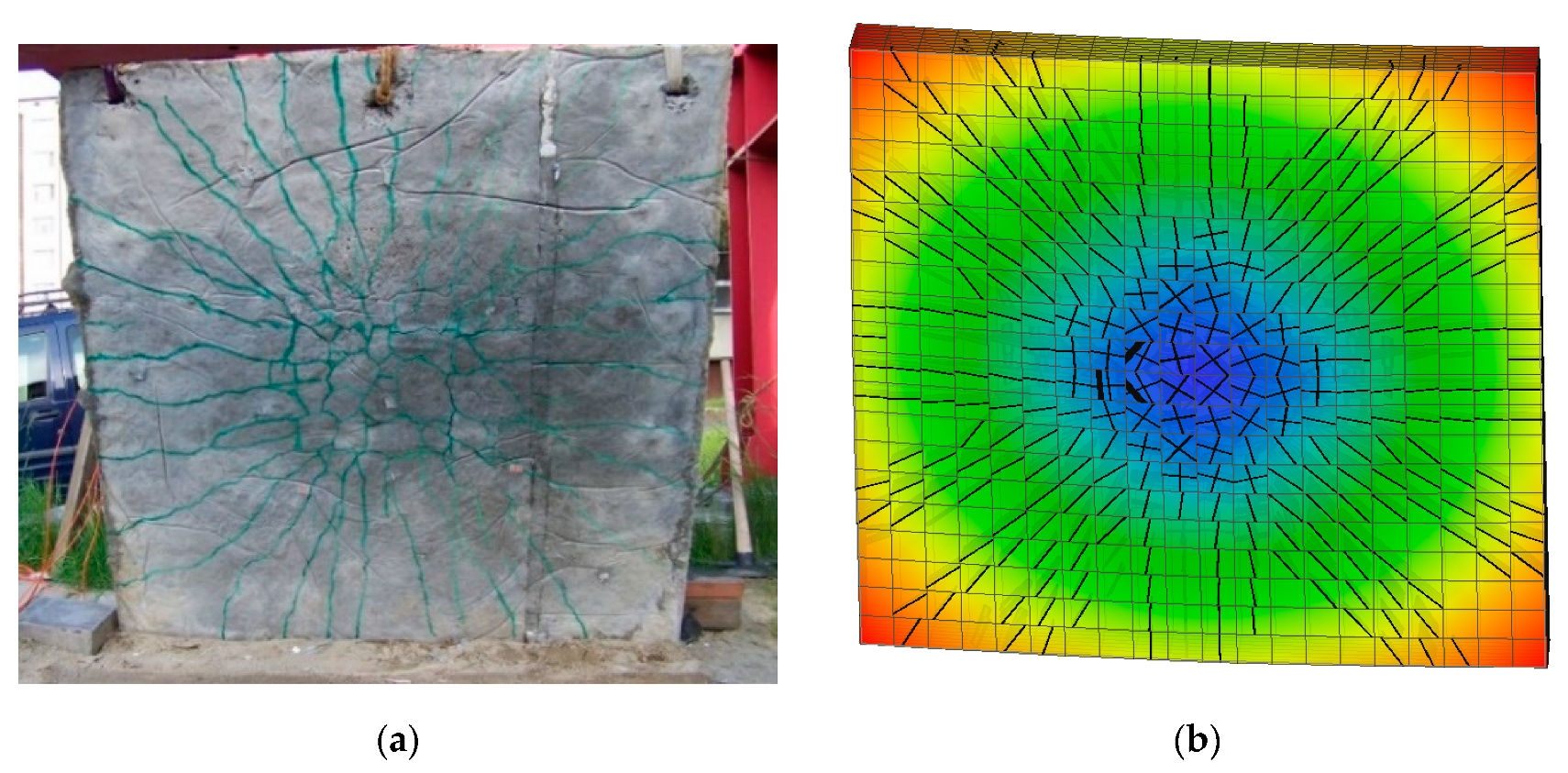
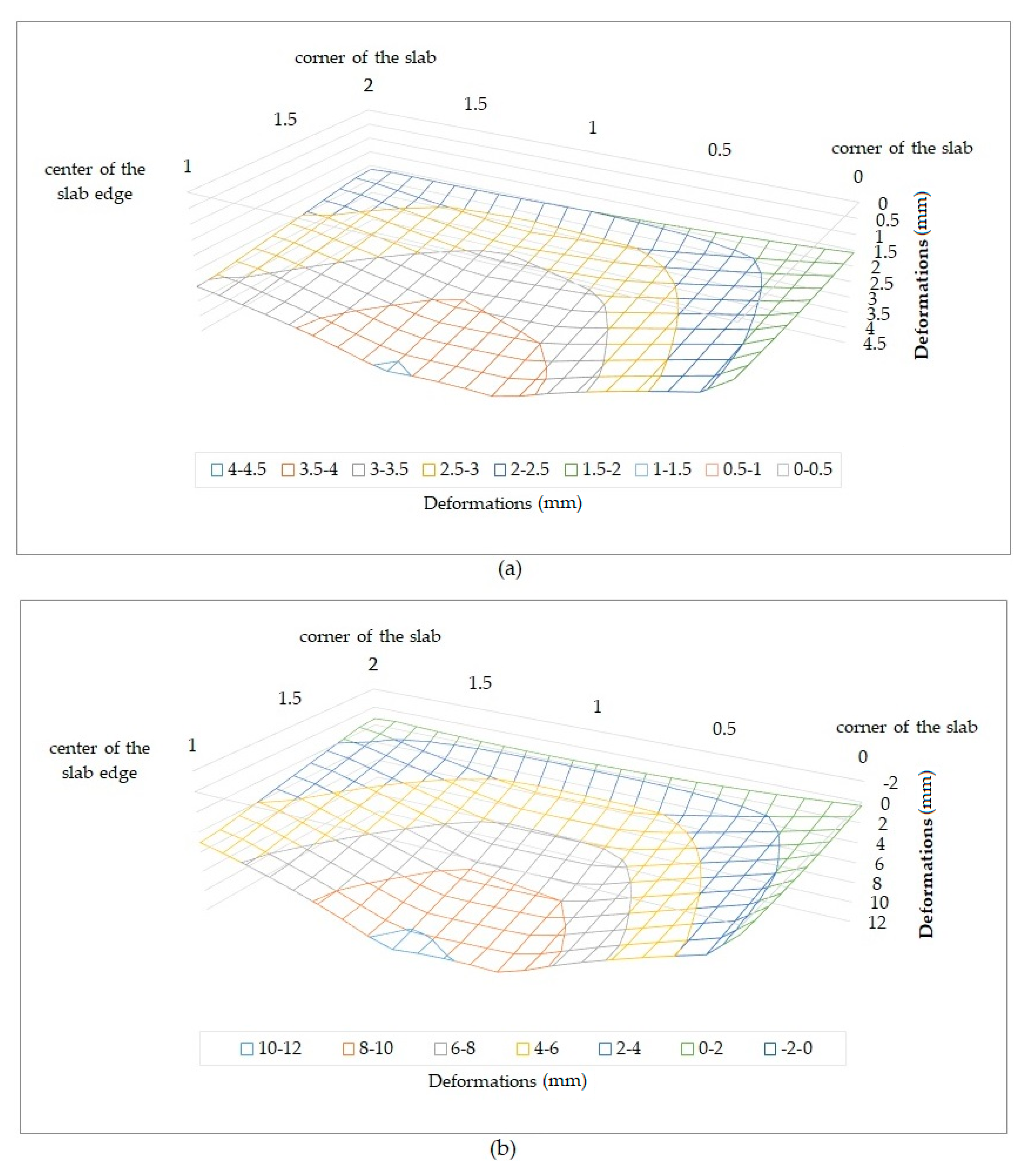
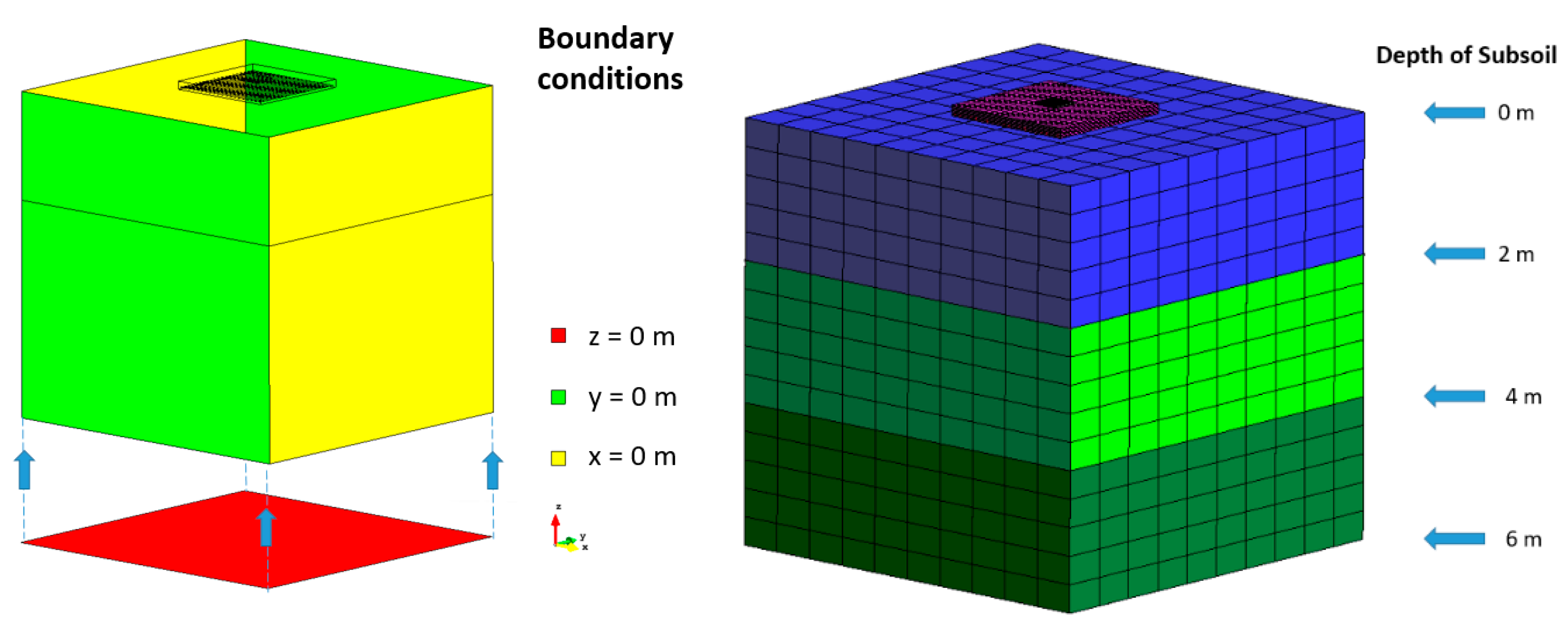
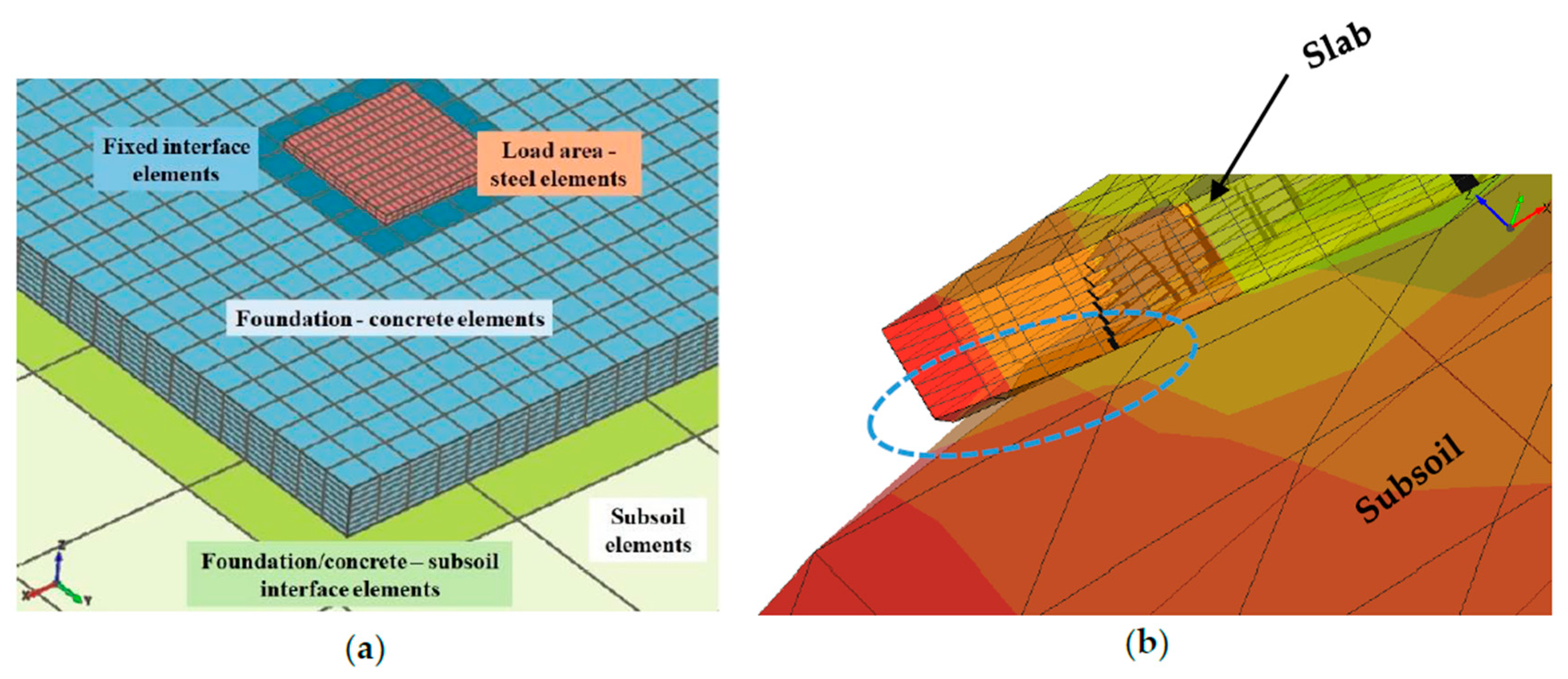
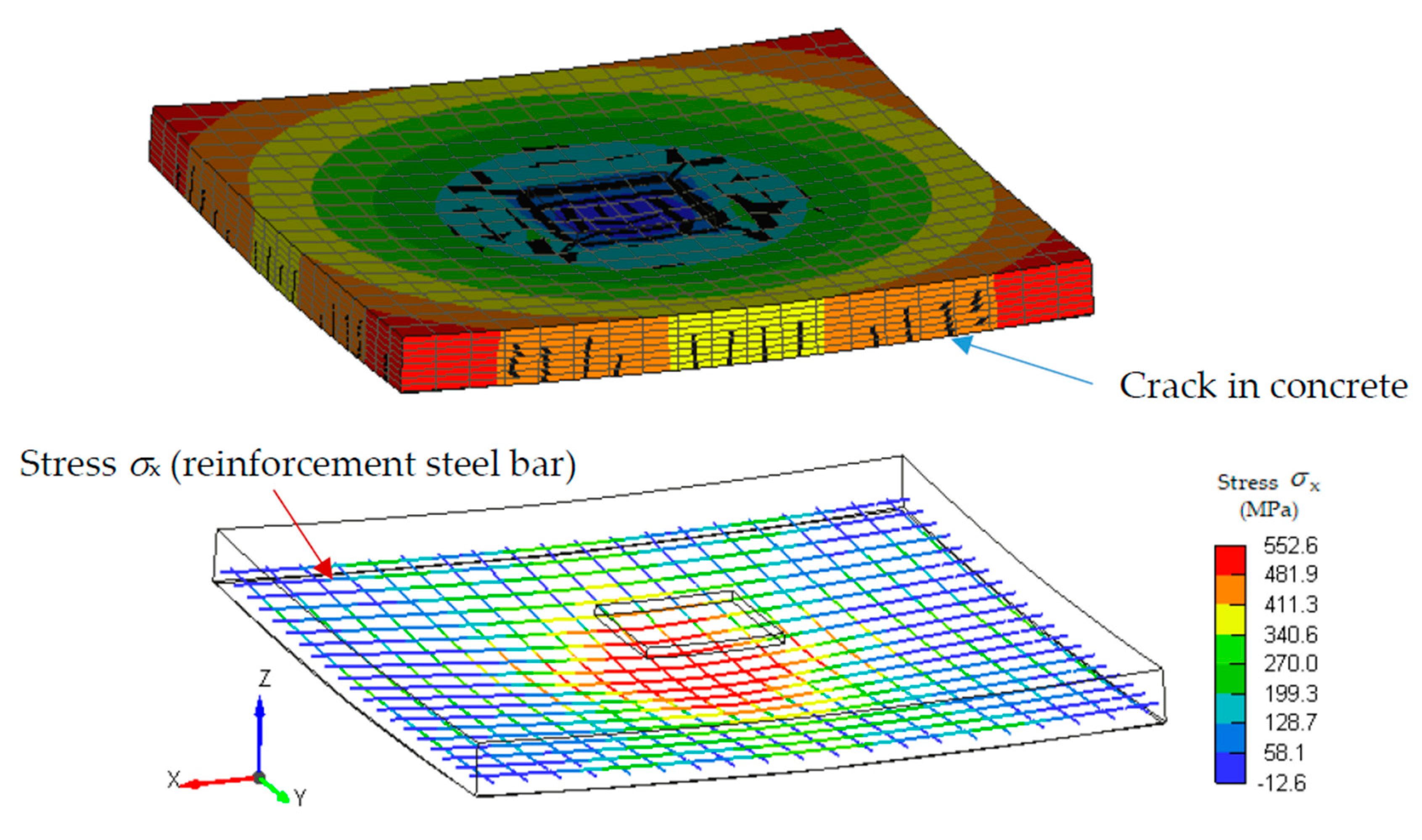
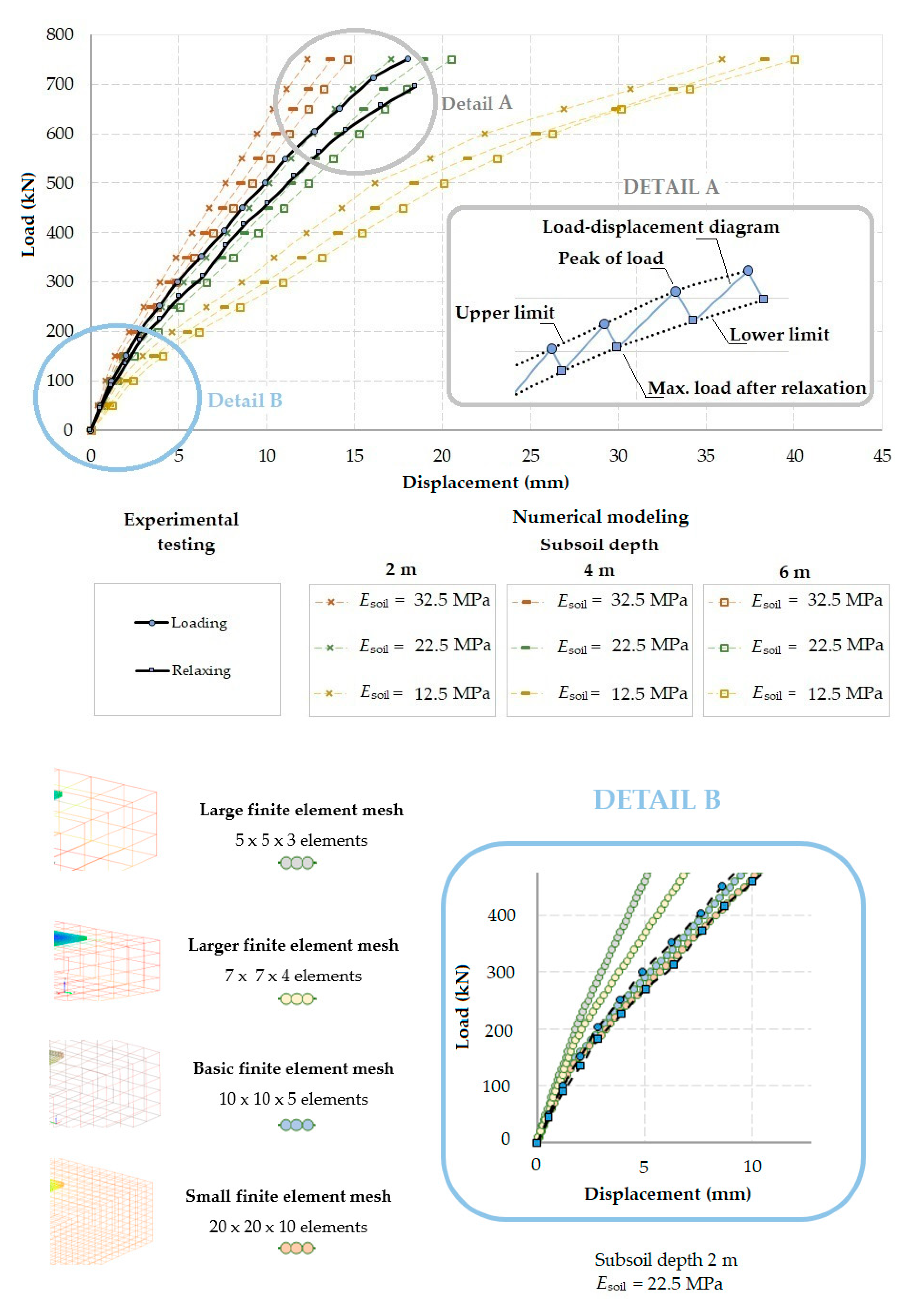
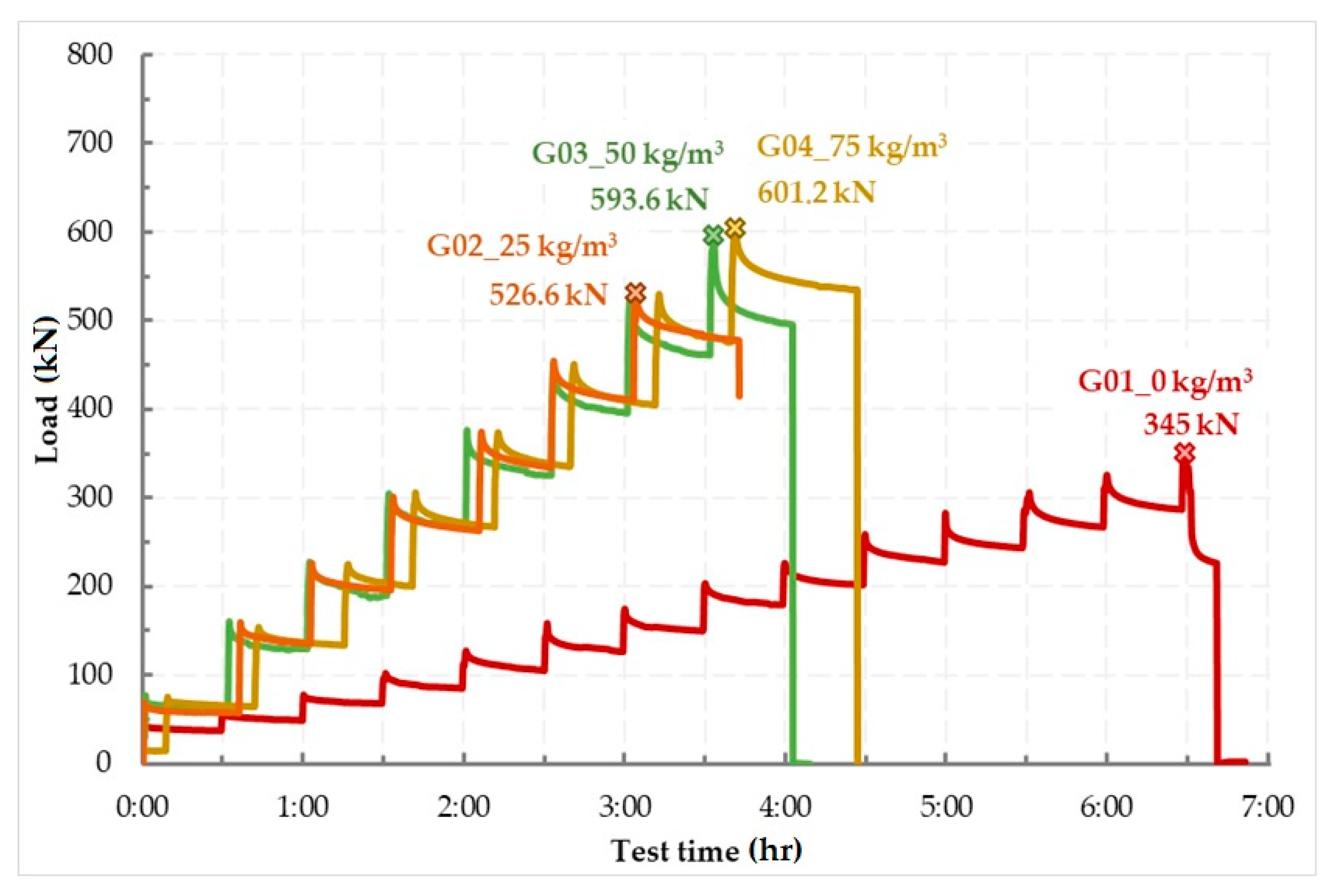


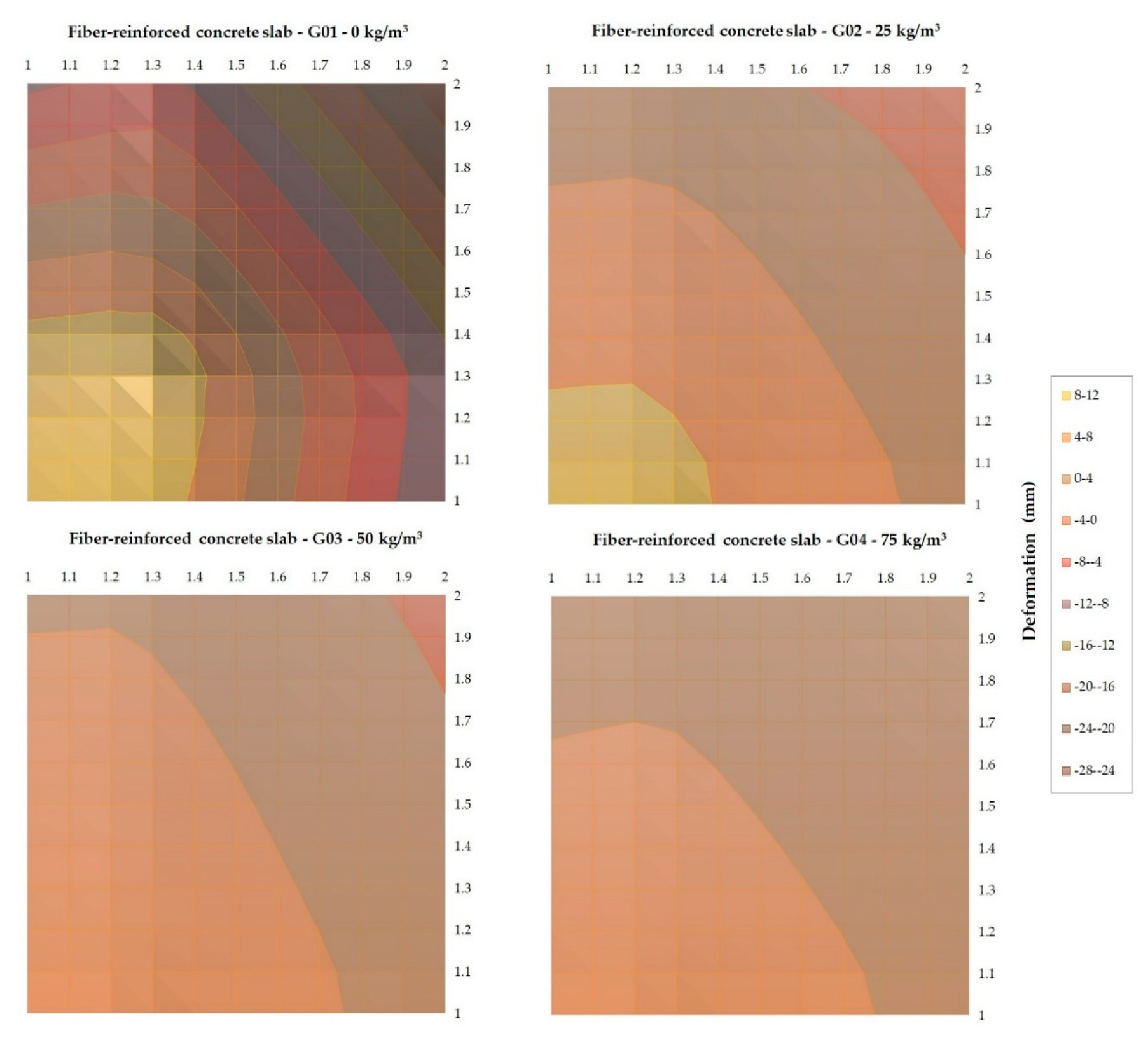
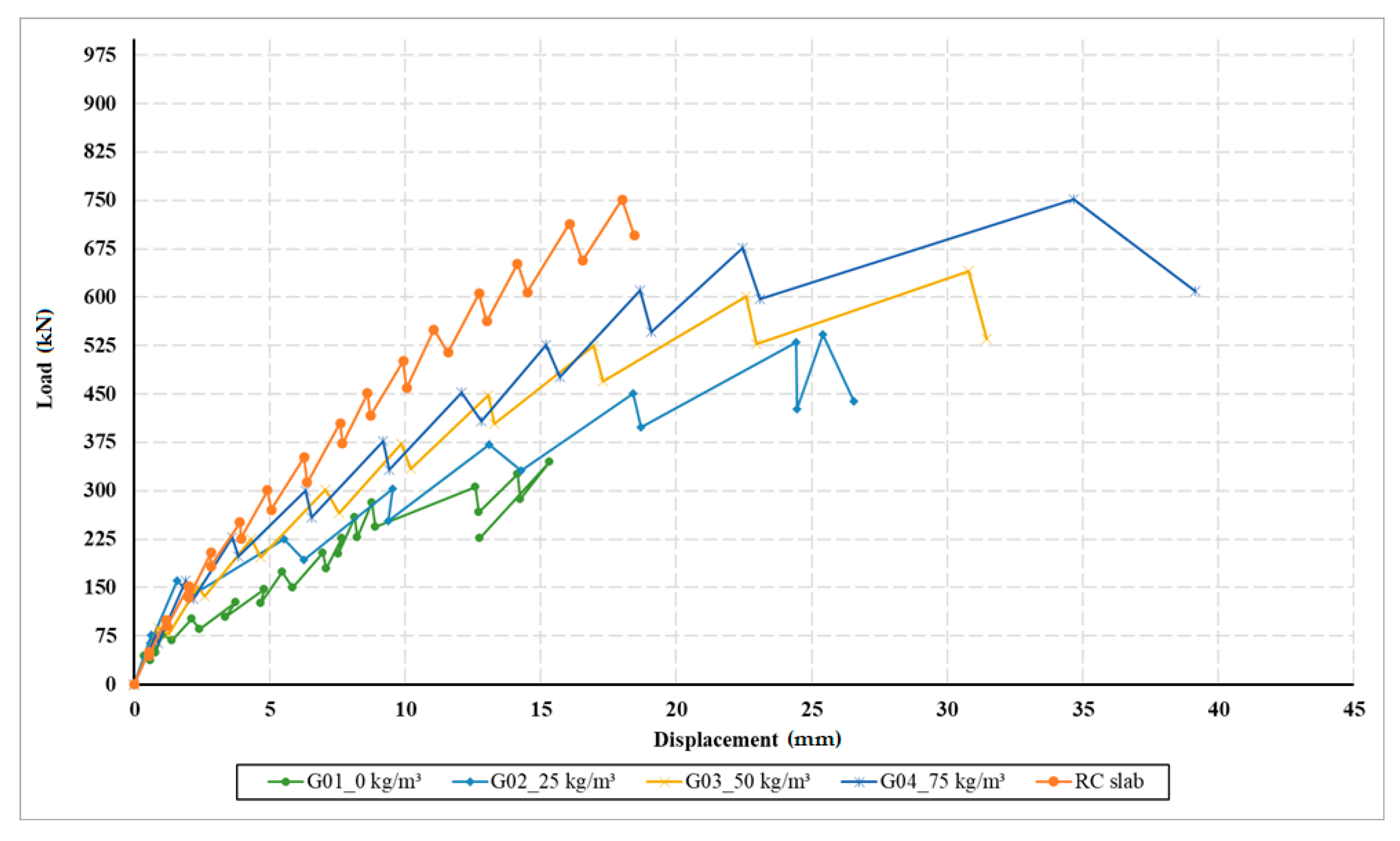
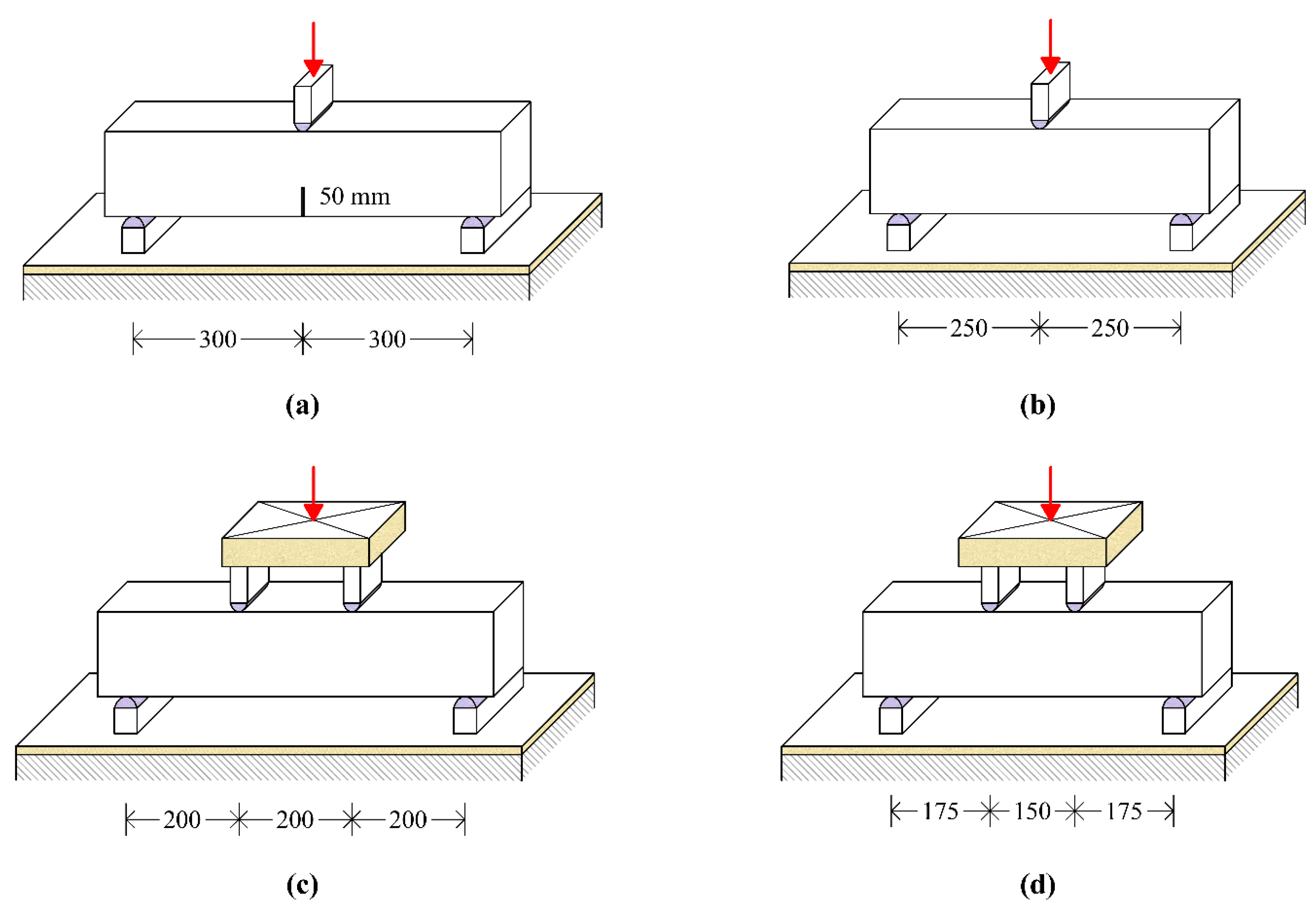

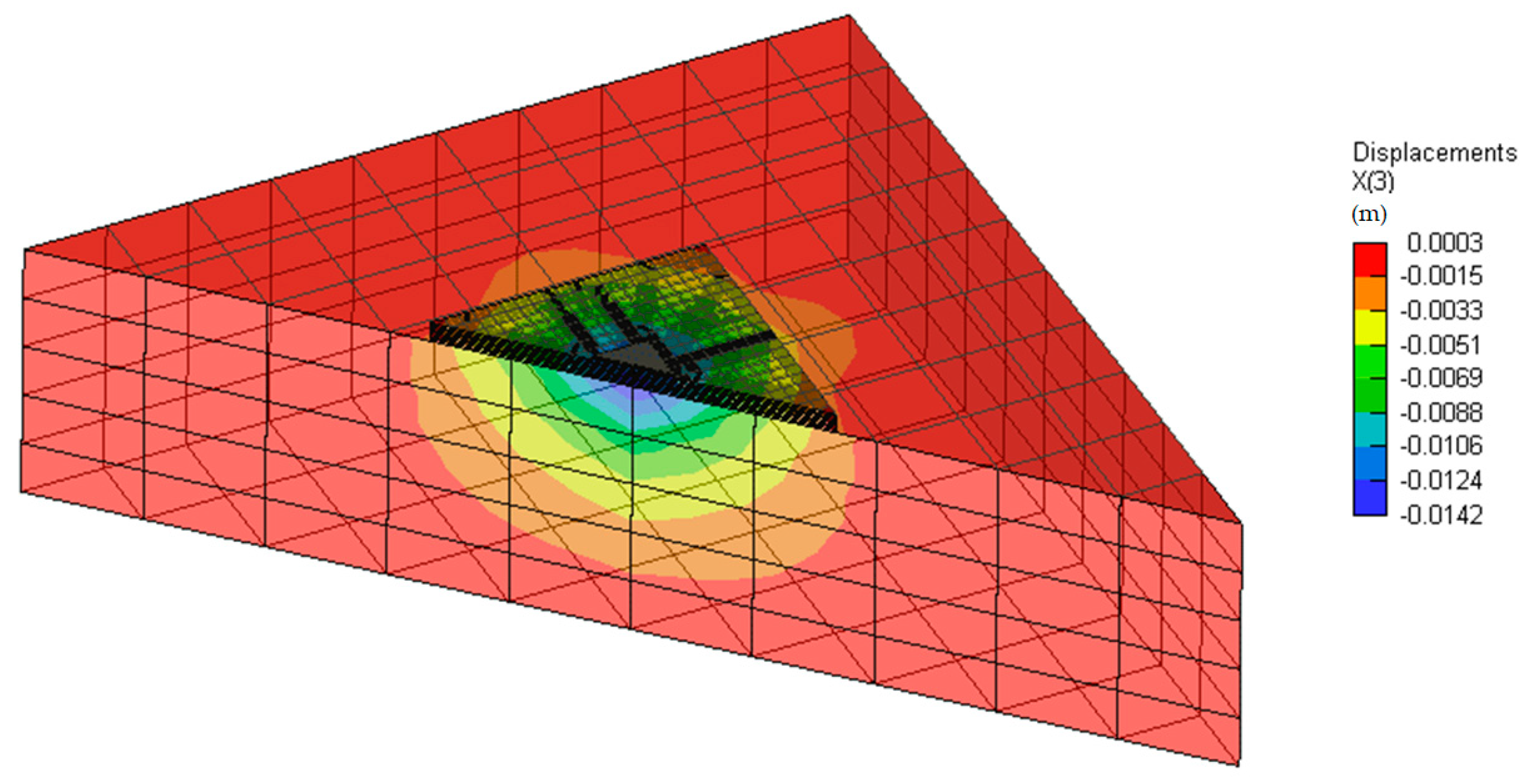
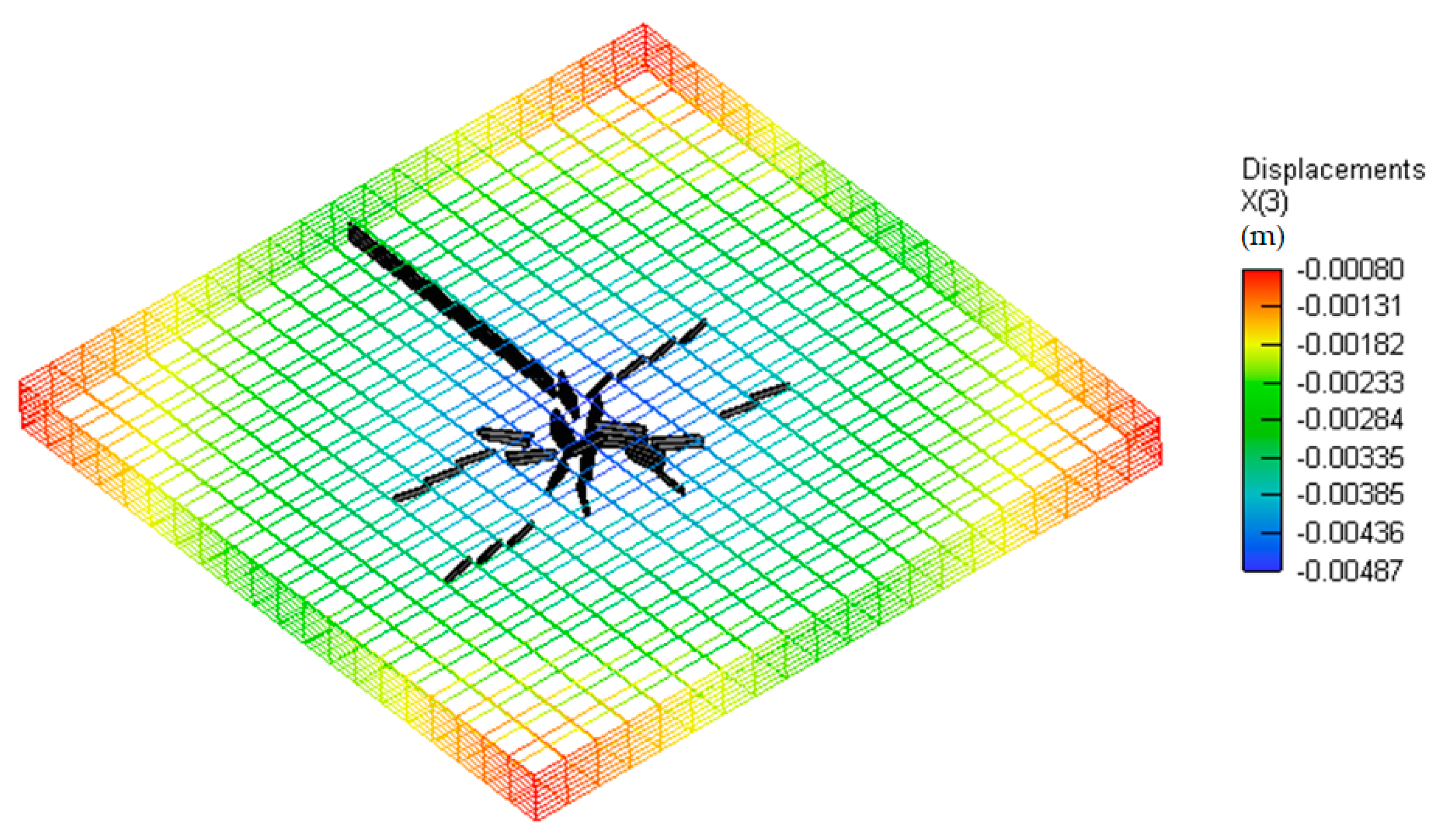


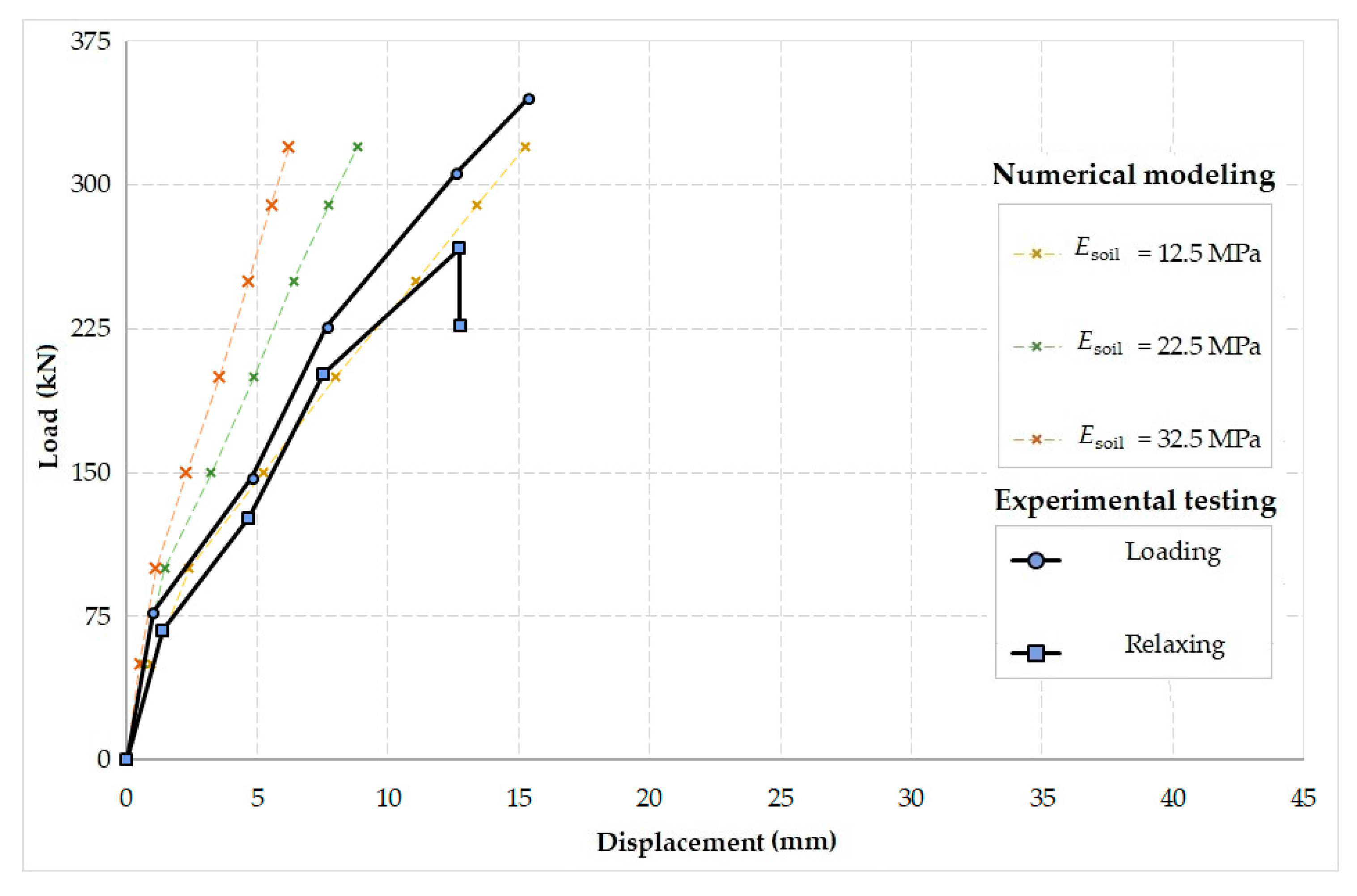

| C (MPa) | fcoef | ften (MPa) | Knn (MN/m3) | Ktt (MN/m3) | Knn,min (MN/m3) | Ktt,min (MN/m3) |
|---|---|---|---|---|---|---|
| 1.0 | 0.1 | 0.3 | 2.0 × 108 | 2.0 × 108 | 2.0 × 105 | 2.0 × 105 |
| Deformation Modulus of the Subsoil (MPa) | Load (kN) | Subsoil of Depth (m) | ||
|---|---|---|---|---|
| 2 | 4 | 6 | ||
| 12.5 | 150 | 2.92 | 3.57 | 4.08 |
| 300 | 8.60 | 9.90 | 10.91 | |
| 450 | 14.25 | 16.19 | 17.73 | |
| 600 | 22.40 | 25.30 | 26.25 | |
| 750 | 35.91 | 38.33 | 40.02 | |
| 22.5 | 150 | 1.80 | 2.15 | 2.43 |
| 300 | 5.28 | 6.00 | 6.57 | |
| 450 | 9.00 | 10.10 | 10.96 | |
| 600 | 12.62 | 14.10 | 15.23 | |
| 750 | 17.07 | 18.92 | 20.48 | |
| 32.5 | 150 | 1.37 | 1.61 | 1.81 |
| 300 | 3.92 | 4.44 | 4.82 | |
| 450 | 6.71 | 7.50 | 8.08 | |
| 600 | 9.47 | 10.52 | 11.29 | |
| 750 | 12.32 | 13.62 | 14.60 | |
| Fibers (kg/m3)|(%) | Average Compressive Strength Cylinder|Cube (MPa) | Average Split Tensile Strength (MPa) | Bending Tensile Strength (MPa) | |||
|---|---|---|---|---|---|---|
| Type of Test | ||||||
| 3B500 | 3B600 | 4B600 | 4B500 | |||
| 0|0 | 20.03|25.11 | 2.10 | 3.02 | 2.89 | 2.55 | 2.85 |
| 25|0.32 | 29.28|34.96 | 2.96 | 4.04 | 3.81 | 3.10 | 3.76 |
| 50|0.64 | 25.27|31.65 | 3.12 | 4.41 | 4.24 | 3.56 | 4.06 |
| 75|0.96 | 24.90|27.87 | 3.17 | 4.72 | 5.16 | 4.35 | 4.95 |
| Input Parameter | Unit | Marker of Slab|Fibers (%) | |||
|---|---|---|---|---|---|
| G01|0 | G02|0.32 | G03|0.64 | G01|0.96 | ||
| Modulus of elasticity | GPa | 19.51 | 19.51 | 19.51 | 19.51 |
| Compression strength | MPa | 21.34 | 29.71 | 26.90 | 23.69 |
| Poisson’s ratio | - | 0.2 | 0.2 | 0.2 | 0.2 |
| Tension strength | MPa | 1.89 | 2.66 | 2.81 | 2.85 |
| Fracture energy | N/m | 47 | 225 | 1100 | 2500 |
| Fixed crack | - | 1 | 1 | 1 | 1 |
| Maximum aggregate size | mm | 16 | 16 | 16 | 16 |
| Reduction coefficient Fc, red | - | 0.8 | 1 | 1 | 1 |
| Shear factor | - | 20 | 20 | 20 | 20 |
| Fracture energy | N/m | 47 | 225 | 1100 | 2500 |
Publisher’s Note: MDPI stays neutral with regard to jurisdictional claims in published maps and institutional affiliations. |
© 2020 by the authors. Licensee MDPI, Basel, Switzerland. This article is an open access article distributed under the terms and conditions of the Creative Commons Attribution (CC BY) license (http://creativecommons.org/licenses/by/4.0/).
Share and Cite
Cajka, R.; Marcalikova, Z.; Bilek, V.; Sucharda, O. Numerical Modeling and Analysis of Concrete Slabs in Interaction with Subsoil. Sustainability 2020, 12, 9868. https://doi.org/10.3390/su12239868
Cajka R, Marcalikova Z, Bilek V, Sucharda O. Numerical Modeling and Analysis of Concrete Slabs in Interaction with Subsoil. Sustainability. 2020; 12(23):9868. https://doi.org/10.3390/su12239868
Chicago/Turabian StyleCajka, Radim, Zuzana Marcalikova, Vlastimil Bilek, and Oldrich Sucharda. 2020. "Numerical Modeling and Analysis of Concrete Slabs in Interaction with Subsoil" Sustainability 12, no. 23: 9868. https://doi.org/10.3390/su12239868
APA StyleCajka, R., Marcalikova, Z., Bilek, V., & Sucharda, O. (2020). Numerical Modeling and Analysis of Concrete Slabs in Interaction with Subsoil. Sustainability, 12(23), 9868. https://doi.org/10.3390/su12239868






